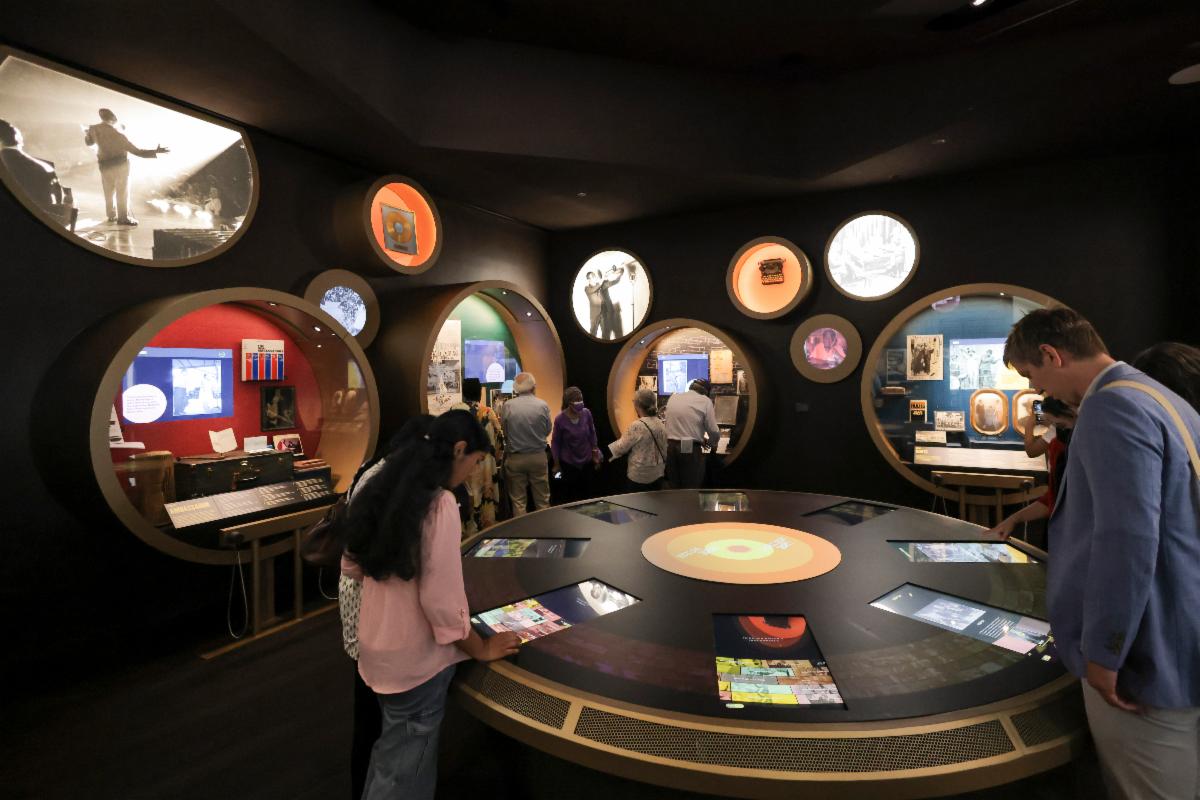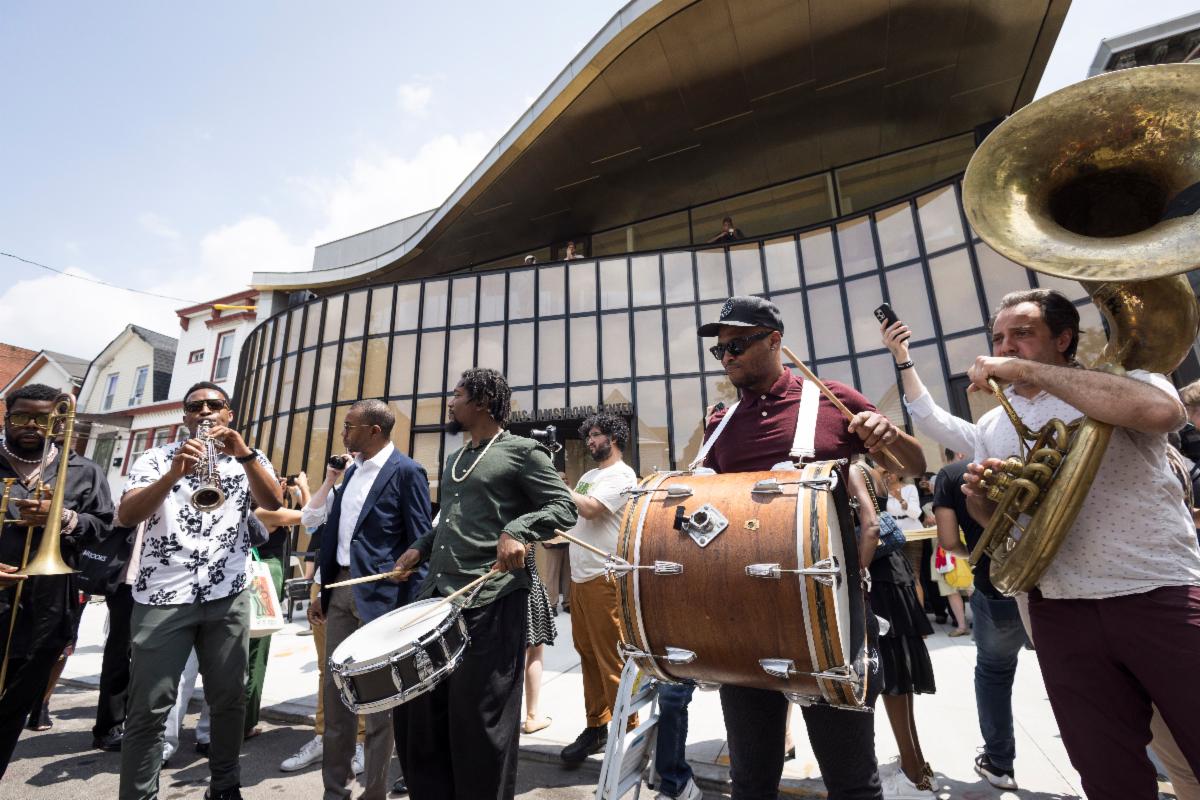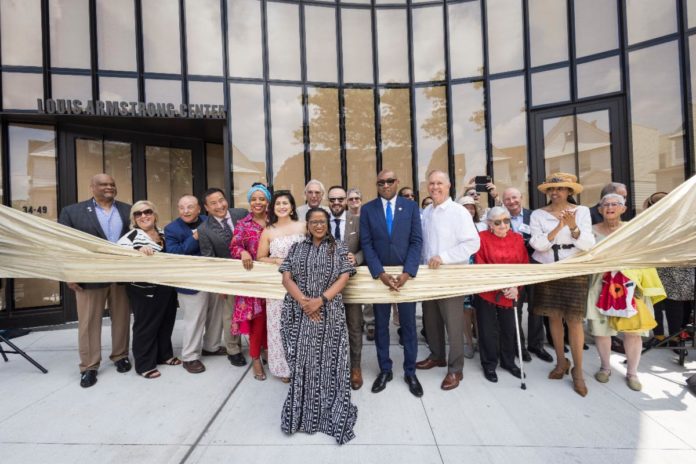Yesterday, the internationally renowned Louis Armstrong House Museum in Corona, Queens held a ceremonial ribbon cutting with fitting trumpet fanfare to celebrate its new state-of-the-art center and archive – the world’s largest for a jazz musician. Opening to the public on Thursday, July 6, the new center will preserve and expand the legacy and ideals of America’s first Black popular music icon, Louis Armstrong.
Opening remarks were made by the museum’s Executive Director Regina Bainand Board Chair Jay Hershenson, followed by speeches from New York State Senator Jessica Ramos, New York State Assemblyman Jeffrion Aubry, Queens Borough President Donovan Richards, NYC Council Member Francisco Moya, The City University of New York (CUNY) Chancellor Félix V. Matos Rodríguez, Queens College President Frank H. Wu, Cultural Affairs Commissioner Laurie Cumbo and community leaders. Guests were treated to performances by Kennedy Center Artistic Director for Jazz, pianist, composer and curator of the new Center’s Here to Stay exhibition Jason Moran, Danny Jonokuchi, Christopher McBride and the Queens College All-Stars, Calvin Johnson and Native Soul, as well as students from Frank Sinatra High School. Fittingly, the day featured a trumpet fanfare with a line-up of world renown trumpeters: Bria Skonberg, Jon Faddis, Jon-Erik Kellso, Steven Bernstein, Frank Greene, Bruce Harris, Riley Mulherkar, Linda Briceño, Summer Camargo, Kali Rodriguez, David Adewumi, Tatum Greenblatt, and Danny Jonokuchi. The day concluded with a jam session, center open house with tours, archival sneak peek and a special toast.
The Louis Armstrong Center will officially open to the public on Thursday, July 6 – tickets here. Armstrong’s values of Artistic Excellence, Education and Community will be fostered in Here to Stay, a new exhibition curated by Jason Moran that looks at Armstrong’s five-decade career as an innovative musician, rigorous archivist, consummate collaborator and community builder. Grounded in the new building design by Caples Jefferson Architects, the new Center will also be a permanent home for the 60,000-piece Louis Armstrong Archive and a 75-seat venue offering performances, lectures, films, and educational experiences.
It will be a new international destination celebrating Armstrong’s distinctive role in African-Diaspora history and vitality, offering year-round exhibitions, performances, readings, lectures, and screenings through an array of public programs for all ages. With longstanding partners Queens College and the Louis Armstrong Educational Foundation, and with a growing list of members, supporters and programmatic collaborators, the museum and center will become a Queens-based hub for inspiration and learning, economic development and tourism – from New Yorkers to the world.
“Louis Armstrong was one of the greatest musicians of the 20th century, and also a beloved member of the community here in Corona, Queens,” said NYC Cultural Affairs Commissioner Laurie Cumbo. “This new education center and archive will keep both aspects of Armstrong’s legacy alive for generations to come – both the consummate artist and musician, and the incredible neighbor who treated local kids to ice cream each year on the 4th of July. We’re proud of the city’s major investment of over $10 million in this project, a long term commitment to the cultural vitality of Corona and in preserving the legacy of Louis Armstrong. Schedule your visit to Satchmo’s house today!”
The opening of the Center has spurred the creation of new programming. The Museum just announced the upcoming season of its groundbreaking Armstrong Now, which will feature the creation and debut of new works by Esperanza Spalding, Amyra León and Antonio Brown. An outreach program to local schools was also recently launched, providing trumpet lessons made possible by a donation of musical instruments from Ken Karnofsky, a descendant of the same family who helped Armstrong buy his first instrument.

Credit: Bowery Image Group/Andrew Kelly
This National Historic Landmark museum welcomes its new addition across the street during the 80th anniversary of Louis and Lucille Armstrong moving to the legendary jazz trumpeter & singer’s restored home. Visitors have included Wynton Marsalis, Quincy Jones, Tony Bennett, Charlie Watts, Ken Burns, Jon Batiste, Ron Howard, Bette Midler and many more.
“Louis Armstrong is the greatest of all American virtuosos,” states Wynton Marsalis, President of the Louis Armstrong Educational Foundation and Managing and Artistic Director of Jazz at Lincoln Center. “With his trumpet and voice, Armstrong redefined what it meant to be modern by testifying to the range and depth of humanity from the vantage point of the bottom social strata in post-Reconstruction America. Louis Armstrong’s trumpet is the sound of freedom and with it, he left the world so much richer than how he found it. We need his consciousness, intelligence and broad understanding now, more than ever. The Louis Armstrong Educational Foundation was the baseline grantor of the Louis Armstrong House Museum and we have been in full support throughout the growth of this historic site. We are so proud of the Museum, and now, the new Armstrong Center. This great achievement is a physical representation of the down-home soulful world of Pops. It is much, much more than just a place. It’s a way for all people from everywhere to physically interact with the profound and deeply moving legacy of Lucille and Louis Armstrong.”

Credit: Bowery Image Group/Andrew Kelly
Working with the museum’s Grammy-winning Director of Research Collections Ricky Riccardi and Executive Director Regina Bain, C&G Partners (MoMA, 9/11 Memorial & Museum, Smithsonian, NASA) designed the exhibition with Art Guild(Brooklyn Botanic Garden, Martin Guitar Museum). The 60,000 photos, recordings, manuscripts, letters & mementos in the Louis Armstrong Archive will be returning home to the block where the Armstrongs lived and built the collection.
Caples Jefferson Architects designed the 14,000-square-foot building to expand the capacity of the historic house museum and to allow many more people to appreciate the legacy of Louis Armstrong, the man and his music. Armstrong was both down-home and revolutionary and this building reflects that breadth. Caples Jefferson kept the building at the scale of the modest neighborhood that he loved, while creating an urban precinct for his music that welcomes in all visitors. This new building establishes the final piece of the campus that now comprises the museum as whole; it now includes the home itself that reflects the personal values of Louis Armstrong, the garden that serves as a place for gathering and a place for live performances, the donated home of next-door neighbor Selma Heraldo, reflecting the deep roots within the community, and the new center, designed as an interpretation of Armstrong’s music, where the public can learn even more about the icon who is Louis Armstrong.
The Louis Armstrong Educational Foundation donated the Armstrong archives in the 1980s and provided the funds to purchase the lot on which the new Center sits. CUNY and Queens College officials, working with state and city legislators and executive offices, led the advocacy for the funding of the $26 million building across the street from the original Armstrong home. Funds were awarded by the Office of the Governor, the New York State Senate, New York State Assembly, Office of the New York City Mayor, Office of the Queens Borough President, and the New York City Council. The Dormitory Authority of the State of New York(DASNY) led the construction project. The staff and board of the museum for the past 15 years, including former Director, Michael Cogswell, worked tirelessly to ensure the new building’s success.
The Center and the historic house will be open to the public Thursdays through Saturdays. Tickets can be purchased on the Museum’s website. Advance purchase is highly recommended as tours of the Center and the historic house have limited capacity. Authors, researchers and other scholars can visit the Armstrong archives by advance appointment. For ticketing and more information about the new Center, visit www.louisarmstronghouse.org.







